International Property Finance Report 2022
VerifiedAdded on 2022/10/14
|13
|2797
|20
AI Summary
Contribute Materials
Your contribution can guide someone’s learning journey. Share your
documents today.
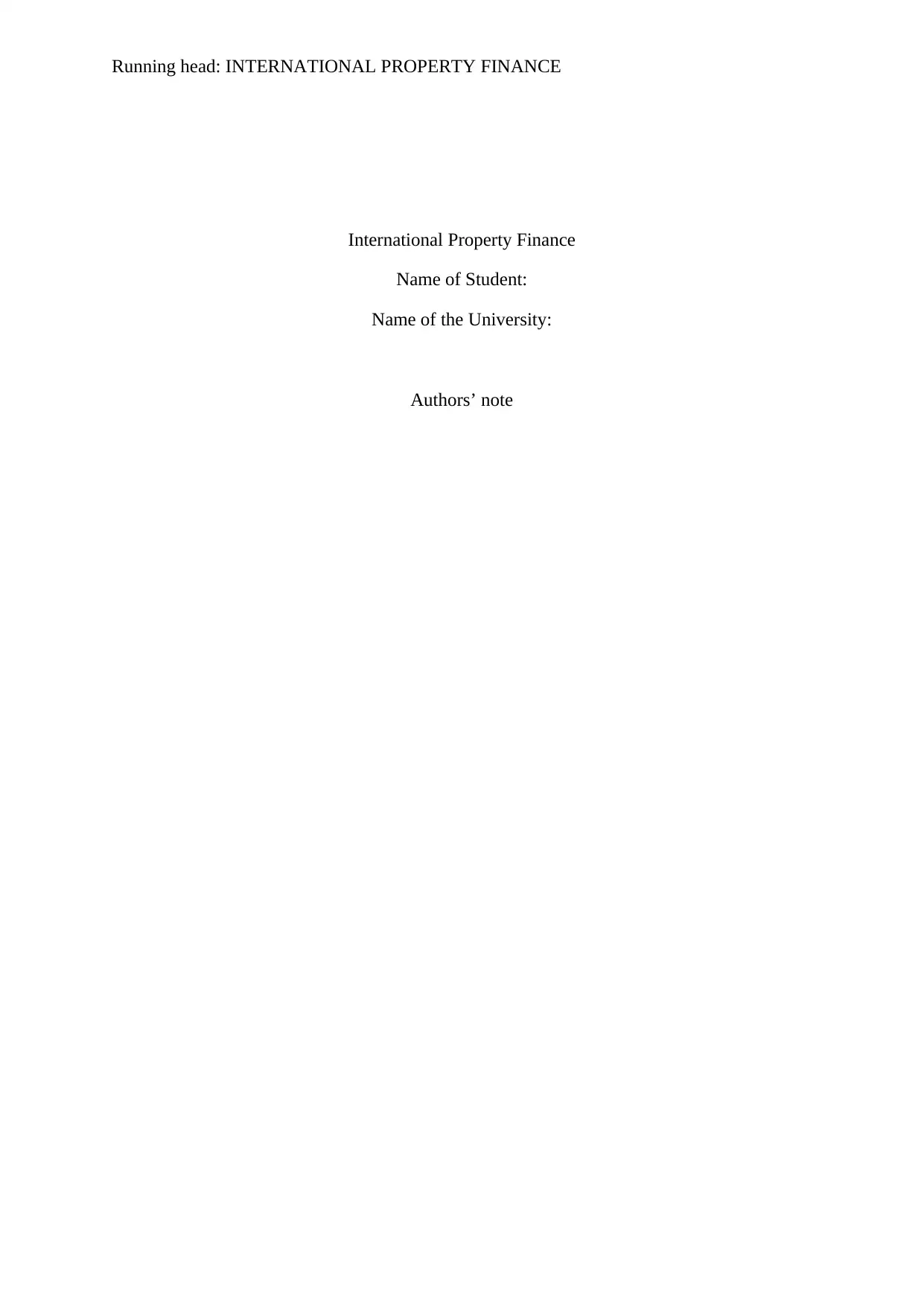
Running head: INTERNATIONAL PROPERTY FINANCE
International Property Finance
Name of Student:
Name of the University:
Authors’ note
International Property Finance
Name of Student:
Name of the University:
Authors’ note
Secure Best Marks with AI Grader
Need help grading? Try our AI Grader for instant feedback on your assignments.
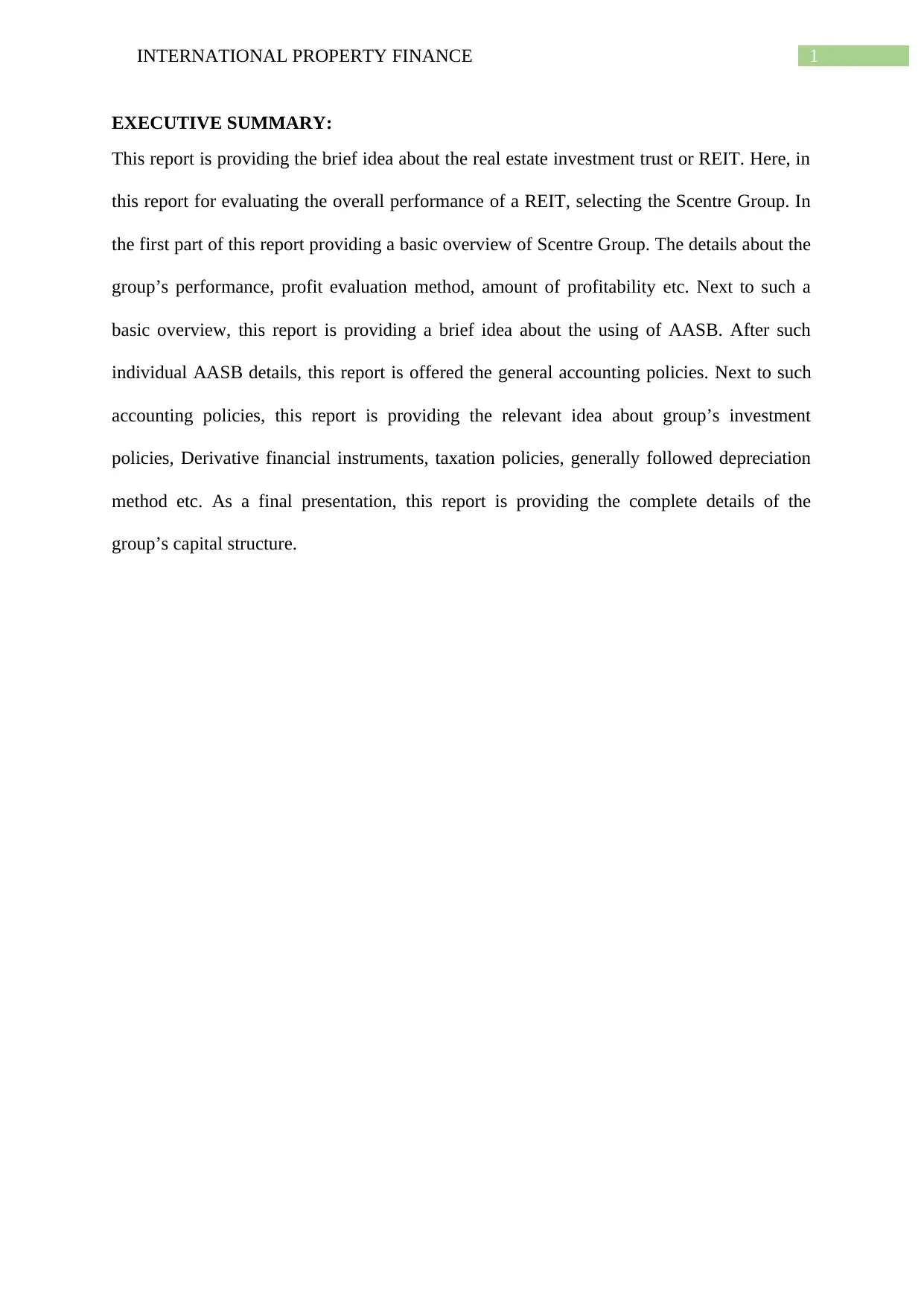
1INTERNATIONAL PROPERTY FINANCE
EXECUTIVE SUMMARY:
This report is providing the brief idea about the real estate investment trust or REIT. Here, in
this report for evaluating the overall performance of a REIT, selecting the Scentre Group. In
the first part of this report providing a basic overview of Scentre Group. The details about the
group’s performance, profit evaluation method, amount of profitability etc. Next to such a
basic overview, this report is providing a brief idea about the using of AASB. After such
individual AASB details, this report is offered the general accounting policies. Next to such
accounting policies, this report is providing the relevant idea about group’s investment
policies, Derivative financial instruments, taxation policies, generally followed depreciation
method etc. As a final presentation, this report is providing the complete details of the
group’s capital structure.
EXECUTIVE SUMMARY:
This report is providing the brief idea about the real estate investment trust or REIT. Here, in
this report for evaluating the overall performance of a REIT, selecting the Scentre Group. In
the first part of this report providing a basic overview of Scentre Group. The details about the
group’s performance, profit evaluation method, amount of profitability etc. Next to such a
basic overview, this report is providing a brief idea about the using of AASB. After such
individual AASB details, this report is offered the general accounting policies. Next to such
accounting policies, this report is providing the relevant idea about group’s investment
policies, Derivative financial instruments, taxation policies, generally followed depreciation
method etc. As a final presentation, this report is providing the complete details of the
group’s capital structure.
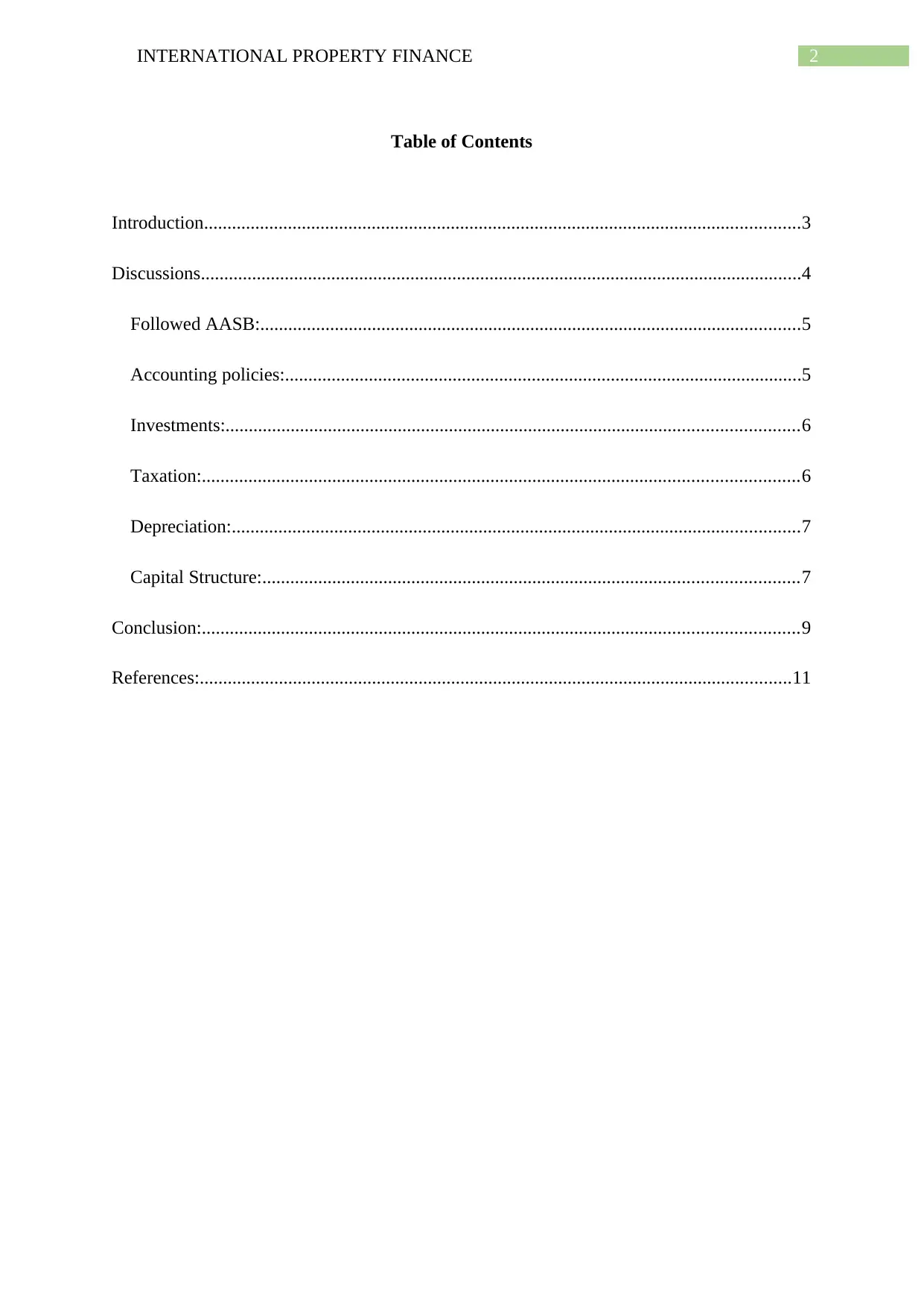
2INTERNATIONAL PROPERTY FINANCE
Table of Contents
Introduction................................................................................................................................3
Discussions.................................................................................................................................4
Followed AASB:....................................................................................................................5
Accounting policies:...............................................................................................................5
Investments:...........................................................................................................................6
Taxation:................................................................................................................................6
Depreciation:..........................................................................................................................7
Capital Structure:...................................................................................................................7
Conclusion:................................................................................................................................9
References:...............................................................................................................................11
Table of Contents
Introduction................................................................................................................................3
Discussions.................................................................................................................................4
Followed AASB:....................................................................................................................5
Accounting policies:...............................................................................................................5
Investments:...........................................................................................................................6
Taxation:................................................................................................................................6
Depreciation:..........................................................................................................................7
Capital Structure:...................................................................................................................7
Conclusion:................................................................................................................................9
References:...............................................................................................................................11
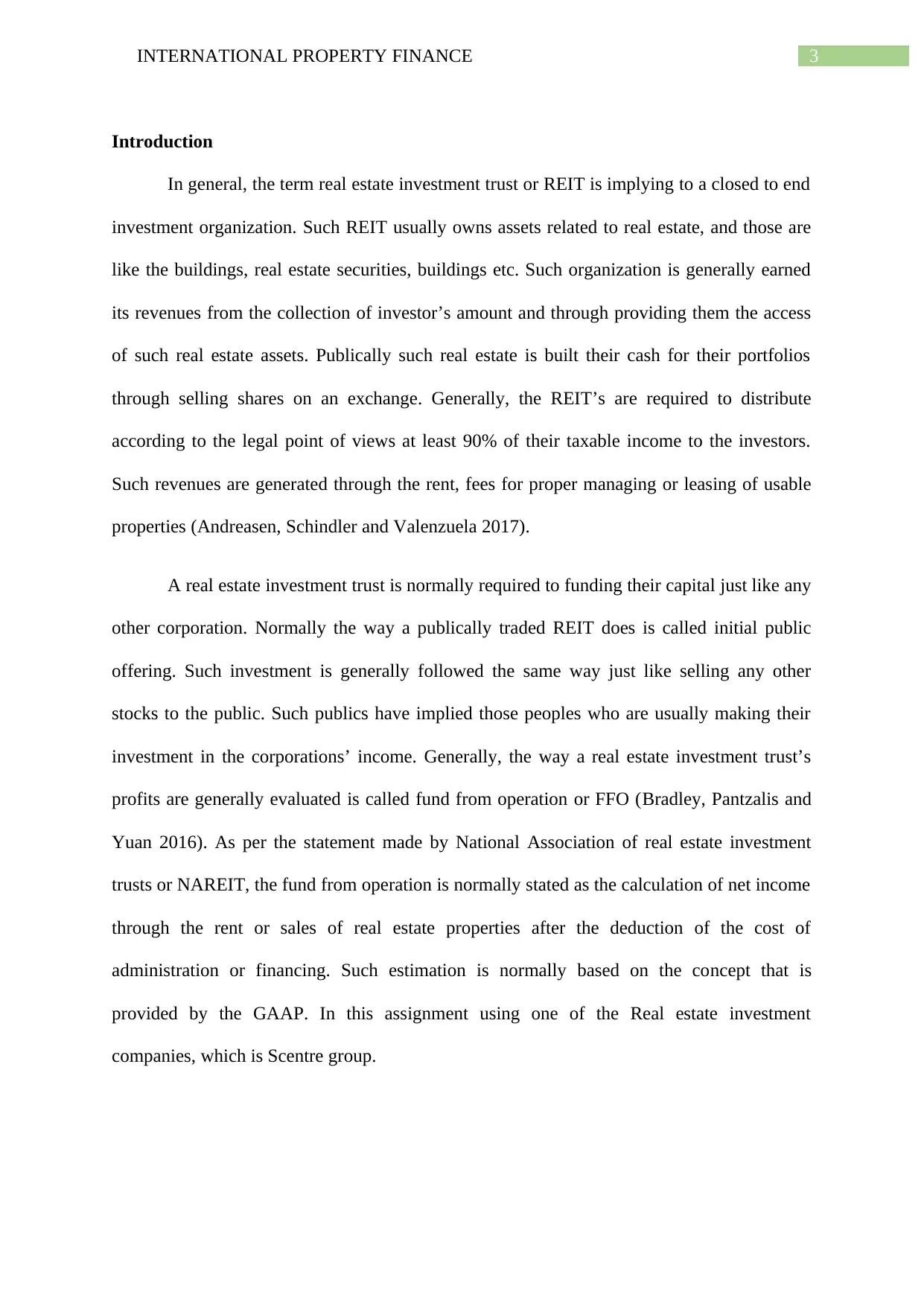
3INTERNATIONAL PROPERTY FINANCE
Introduction
In general, the term real estate investment trust or REIT is implying to a closed to end
investment organization. Such REIT usually owns assets related to real estate, and those are
like the buildings, real estate securities, buildings etc. Such organization is generally earned
its revenues from the collection of investor’s amount and through providing them the access
of such real estate assets. Publically such real estate is built their cash for their portfolios
through selling shares on an exchange. Generally, the REIT’s are required to distribute
according to the legal point of views at least 90% of their taxable income to the investors.
Such revenues are generated through the rent, fees for proper managing or leasing of usable
properties (Andreasen, Schindler and Valenzuela 2017).
A real estate investment trust is normally required to funding their capital just like any
other corporation. Normally the way a publically traded REIT does is called initial public
offering. Such investment is generally followed the same way just like selling any other
stocks to the public. Such publics have implied those peoples who are usually making their
investment in the corporations’ income. Generally, the way a real estate investment trust’s
profits are generally evaluated is called fund from operation or FFO (Bradley, Pantzalis and
Yuan 2016). As per the statement made by National Association of real estate investment
trusts or NAREIT, the fund from operation is normally stated as the calculation of net income
through the rent or sales of real estate properties after the deduction of the cost of
administration or financing. Such estimation is normally based on the concept that is
provided by the GAAP. In this assignment using one of the Real estate investment
companies, which is Scentre group.
Introduction
In general, the term real estate investment trust or REIT is implying to a closed to end
investment organization. Such REIT usually owns assets related to real estate, and those are
like the buildings, real estate securities, buildings etc. Such organization is generally earned
its revenues from the collection of investor’s amount and through providing them the access
of such real estate assets. Publically such real estate is built their cash for their portfolios
through selling shares on an exchange. Generally, the REIT’s are required to distribute
according to the legal point of views at least 90% of their taxable income to the investors.
Such revenues are generated through the rent, fees for proper managing or leasing of usable
properties (Andreasen, Schindler and Valenzuela 2017).
A real estate investment trust is normally required to funding their capital just like any
other corporation. Normally the way a publically traded REIT does is called initial public
offering. Such investment is generally followed the same way just like selling any other
stocks to the public. Such publics have implied those peoples who are usually making their
investment in the corporations’ income. Generally, the way a real estate investment trust’s
profits are generally evaluated is called fund from operation or FFO (Bradley, Pantzalis and
Yuan 2016). As per the statement made by National Association of real estate investment
trusts or NAREIT, the fund from operation is normally stated as the calculation of net income
through the rent or sales of real estate properties after the deduction of the cost of
administration or financing. Such estimation is normally based on the concept that is
provided by the GAAP. In this assignment using one of the Real estate investment
companies, which is Scentre group.
Secure Best Marks with AI Grader
Need help grading? Try our AI Grader for instant feedback on your assignments.
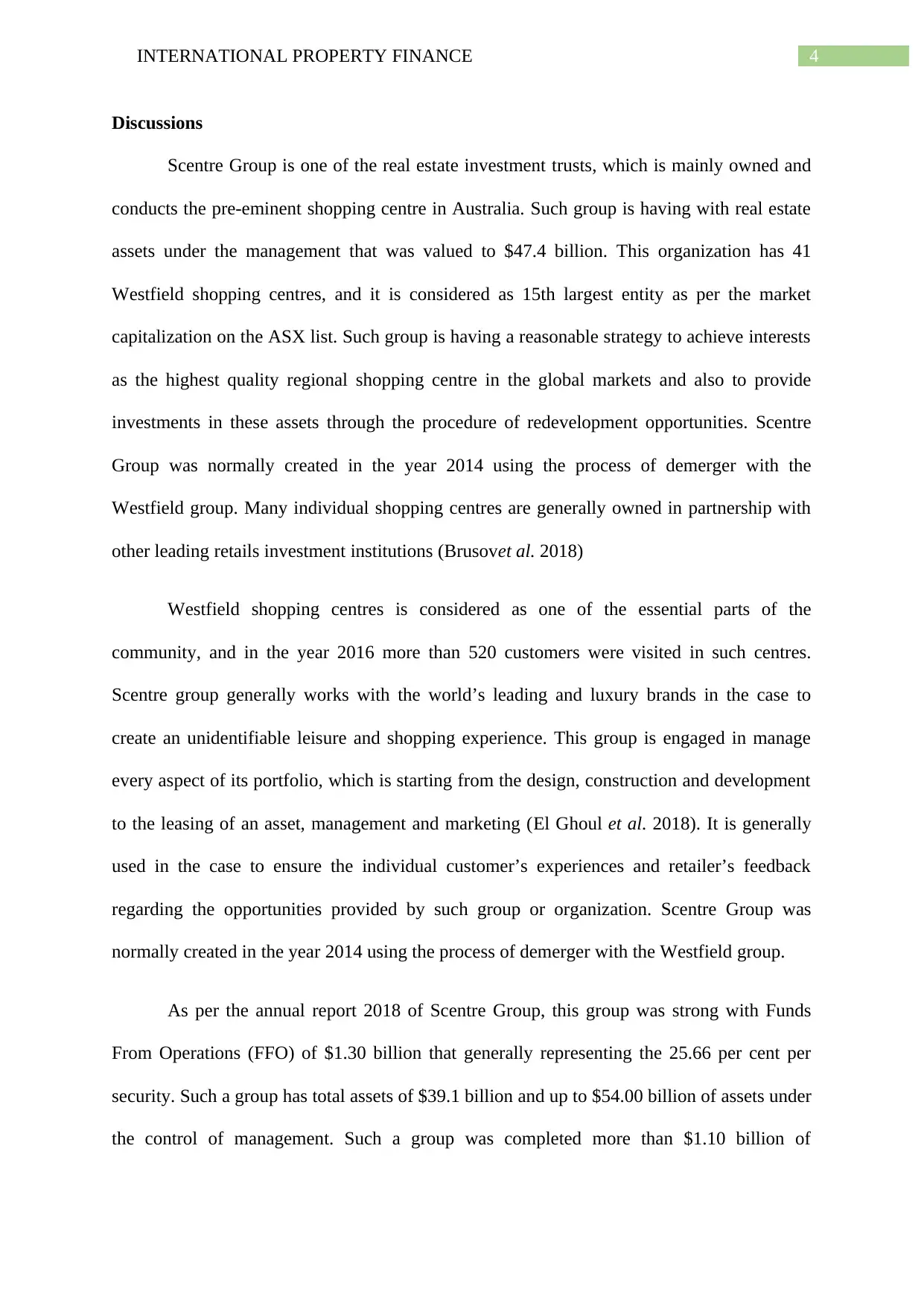
4INTERNATIONAL PROPERTY FINANCE
Discussions
Scentre Group is one of the real estate investment trusts, which is mainly owned and
conducts the pre-eminent shopping centre in Australia. Such group is having with real estate
assets under the management that was valued to $47.4 billion. This organization has 41
Westfield shopping centres, and it is considered as 15th largest entity as per the market
capitalization on the ASX list. Such group is having a reasonable strategy to achieve interests
as the highest quality regional shopping centre in the global markets and also to provide
investments in these assets through the procedure of redevelopment opportunities. Scentre
Group was normally created in the year 2014 using the process of demerger with the
Westfield group. Many individual shopping centres are generally owned in partnership with
other leading retails investment institutions (Brusovet al. 2018)
Westfield shopping centres is considered as one of the essential parts of the
community, and in the year 2016 more than 520 customers were visited in such centres.
Scentre group generally works with the world’s leading and luxury brands in the case to
create an unidentifiable leisure and shopping experience. This group is engaged in manage
every aspect of its portfolio, which is starting from the design, construction and development
to the leasing of an asset, management and marketing (El Ghoul et al. 2018). It is generally
used in the case to ensure the individual customer’s experiences and retailer’s feedback
regarding the opportunities provided by such group or organization. Scentre Group was
normally created in the year 2014 using the process of demerger with the Westfield group.
As per the annual report 2018 of Scentre Group, this group was strong with Funds
From Operations (FFO) of $1.30 billion that generally representing the 25.66 per cent per
security. Such a group has total assets of $39.1 billion and up to $54.00 billion of assets under
the control of management. Such a group was completed more than $1.10 billion of
Discussions
Scentre Group is one of the real estate investment trusts, which is mainly owned and
conducts the pre-eminent shopping centre in Australia. Such group is having with real estate
assets under the management that was valued to $47.4 billion. This organization has 41
Westfield shopping centres, and it is considered as 15th largest entity as per the market
capitalization on the ASX list. Such group is having a reasonable strategy to achieve interests
as the highest quality regional shopping centre in the global markets and also to provide
investments in these assets through the procedure of redevelopment opportunities. Scentre
Group was normally created in the year 2014 using the process of demerger with the
Westfield group. Many individual shopping centres are generally owned in partnership with
other leading retails investment institutions (Brusovet al. 2018)
Westfield shopping centres is considered as one of the essential parts of the
community, and in the year 2016 more than 520 customers were visited in such centres.
Scentre group generally works with the world’s leading and luxury brands in the case to
create an unidentifiable leisure and shopping experience. This group is engaged in manage
every aspect of its portfolio, which is starting from the design, construction and development
to the leasing of an asset, management and marketing (El Ghoul et al. 2018). It is generally
used in the case to ensure the individual customer’s experiences and retailer’s feedback
regarding the opportunities provided by such group or organization. Scentre Group was
normally created in the year 2014 using the process of demerger with the Westfield group.
As per the annual report 2018 of Scentre Group, this group was strong with Funds
From Operations (FFO) of $1.30 billion that generally representing the 25.66 per cent per
security. Such a group has total assets of $39.1 billion and up to $54.00 billion of assets under
the control of management. Such a group was completed more than $1.10 billion of
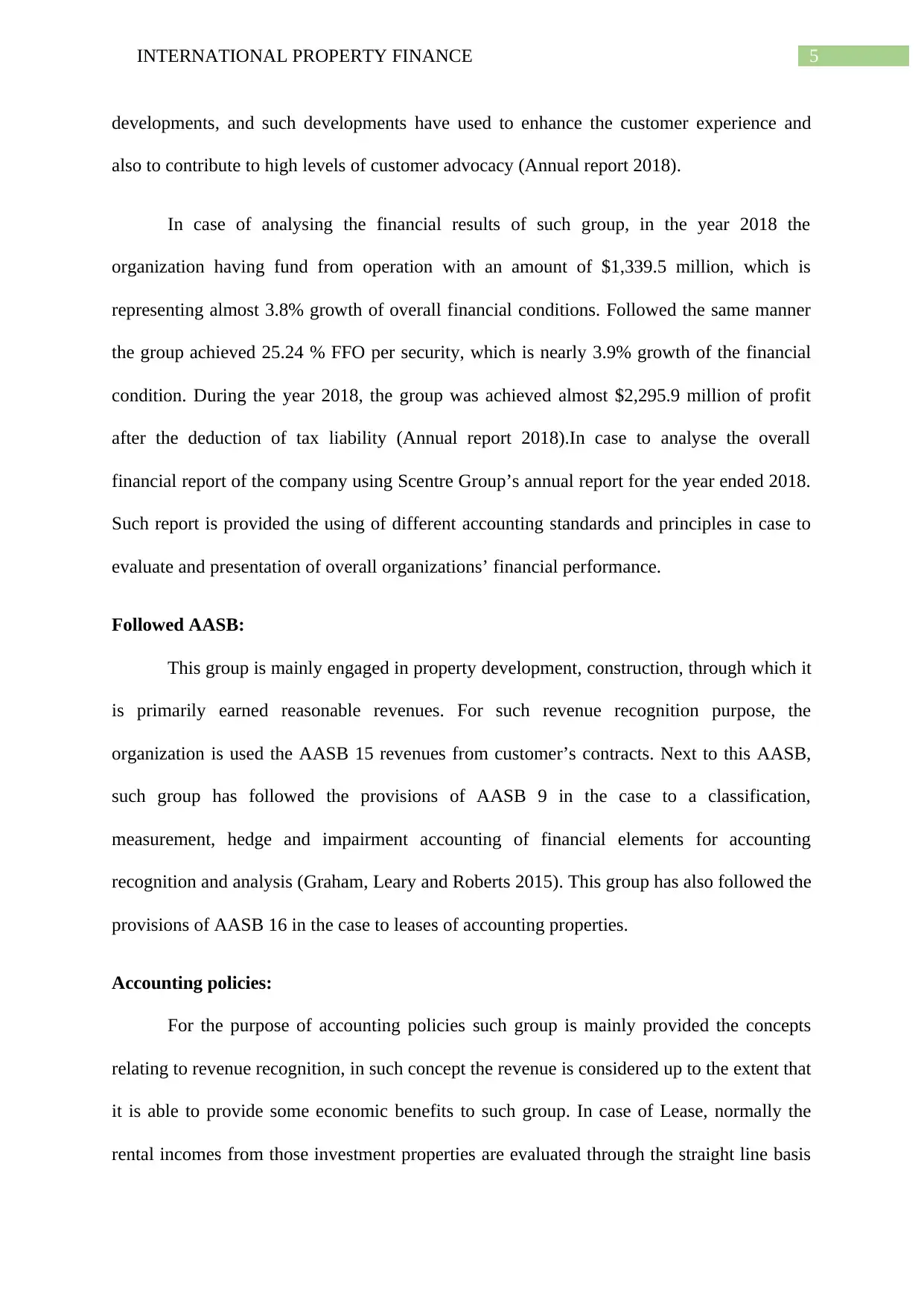
5INTERNATIONAL PROPERTY FINANCE
developments, and such developments have used to enhance the customer experience and
also to contribute to high levels of customer advocacy (Annual report 2018).
In case of analysing the financial results of such group, in the year 2018 the
organization having fund from operation with an amount of $1,339.5 million, which is
representing almost 3.8% growth of overall financial conditions. Followed the same manner
the group achieved 25.24 % FFO per security, which is nearly 3.9% growth of the financial
condition. During the year 2018, the group was achieved almost $2,295.9 million of profit
after the deduction of tax liability (Annual report 2018).In case to analyse the overall
financial report of the company using Scentre Group’s annual report for the year ended 2018.
Such report is provided the using of different accounting standards and principles in case to
evaluate and presentation of overall organizations’ financial performance.
Followed AASB:
This group is mainly engaged in property development, construction, through which it
is primarily earned reasonable revenues. For such revenue recognition purpose, the
organization is used the AASB 15 revenues from customer’s contracts. Next to this AASB,
such group has followed the provisions of AASB 9 in the case to a classification,
measurement, hedge and impairment accounting of financial elements for accounting
recognition and analysis (Graham, Leary and Roberts 2015). This group has also followed the
provisions of AASB 16 in the case to leases of accounting properties.
Accounting policies:
For the purpose of accounting policies such group is mainly provided the concepts
relating to revenue recognition, in such concept the revenue is considered up to the extent that
it is able to provide some economic benefits to such group. In case of Lease, normally the
rental incomes from those investment properties are evaluated through the straight line basis
developments, and such developments have used to enhance the customer experience and
also to contribute to high levels of customer advocacy (Annual report 2018).
In case of analysing the financial results of such group, in the year 2018 the
organization having fund from operation with an amount of $1,339.5 million, which is
representing almost 3.8% growth of overall financial conditions. Followed the same manner
the group achieved 25.24 % FFO per security, which is nearly 3.9% growth of the financial
condition. During the year 2018, the group was achieved almost $2,295.9 million of profit
after the deduction of tax liability (Annual report 2018).In case to analyse the overall
financial report of the company using Scentre Group’s annual report for the year ended 2018.
Such report is provided the using of different accounting standards and principles in case to
evaluate and presentation of overall organizations’ financial performance.
Followed AASB:
This group is mainly engaged in property development, construction, through which it
is primarily earned reasonable revenues. For such revenue recognition purpose, the
organization is used the AASB 15 revenues from customer’s contracts. Next to this AASB,
such group has followed the provisions of AASB 9 in the case to a classification,
measurement, hedge and impairment accounting of financial elements for accounting
recognition and analysis (Graham, Leary and Roberts 2015). This group has also followed the
provisions of AASB 16 in the case to leases of accounting properties.
Accounting policies:
For the purpose of accounting policies such group is mainly provided the concepts
relating to revenue recognition, in such concept the revenue is considered up to the extent that
it is able to provide some economic benefits to such group. In case of Lease, normally the
rental incomes from those investment properties are evaluated through the straight line basis
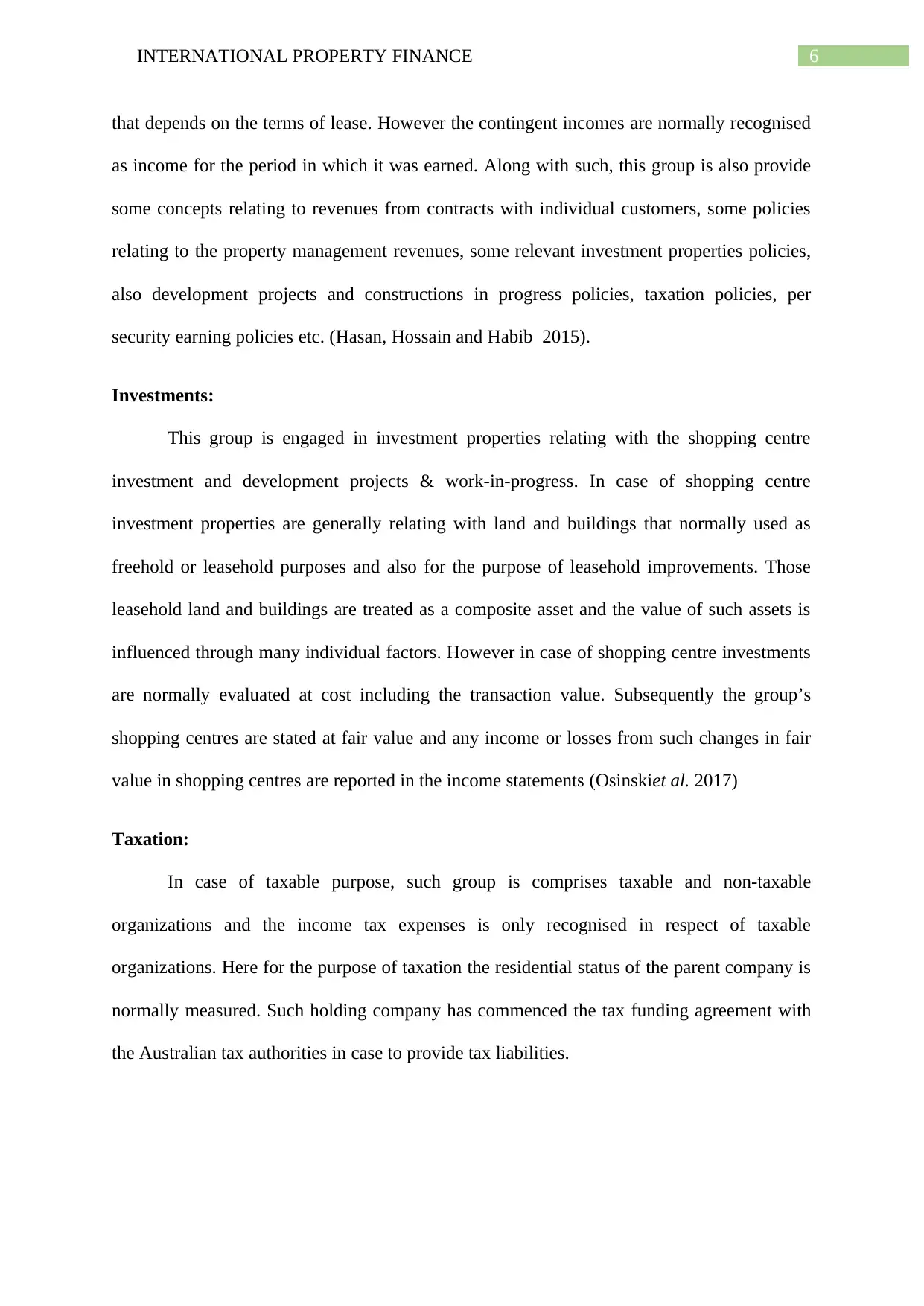
6INTERNATIONAL PROPERTY FINANCE
that depends on the terms of lease. However the contingent incomes are normally recognised
as income for the period in which it was earned. Along with such, this group is also provide
some concepts relating to revenues from contracts with individual customers, some policies
relating to the property management revenues, some relevant investment properties policies,
also development projects and constructions in progress policies, taxation policies, per
security earning policies etc. (Hasan, Hossain and Habib 2015).
Investments:
This group is engaged in investment properties relating with the shopping centre
investment and development projects & work-in-progress. In case of shopping centre
investment properties are generally relating with land and buildings that normally used as
freehold or leasehold purposes and also for the purpose of leasehold improvements. Those
leasehold land and buildings are treated as a composite asset and the value of such assets is
influenced through many individual factors. However in case of shopping centre investments
are normally evaluated at cost including the transaction value. Subsequently the group’s
shopping centres are stated at fair value and any income or losses from such changes in fair
value in shopping centres are reported in the income statements (Osinskiet al. 2017)
Taxation:
In case of taxable purpose, such group is comprises taxable and non-taxable
organizations and the income tax expenses is only recognised in respect of taxable
organizations. Here for the purpose of taxation the residential status of the parent company is
normally measured. Such holding company has commenced the tax funding agreement with
the Australian tax authorities in case to provide tax liabilities.
that depends on the terms of lease. However the contingent incomes are normally recognised
as income for the period in which it was earned. Along with such, this group is also provide
some concepts relating to revenues from contracts with individual customers, some policies
relating to the property management revenues, some relevant investment properties policies,
also development projects and constructions in progress policies, taxation policies, per
security earning policies etc. (Hasan, Hossain and Habib 2015).
Investments:
This group is engaged in investment properties relating with the shopping centre
investment and development projects & work-in-progress. In case of shopping centre
investment properties are generally relating with land and buildings that normally used as
freehold or leasehold purposes and also for the purpose of leasehold improvements. Those
leasehold land and buildings are treated as a composite asset and the value of such assets is
influenced through many individual factors. However in case of shopping centre investments
are normally evaluated at cost including the transaction value. Subsequently the group’s
shopping centres are stated at fair value and any income or losses from such changes in fair
value in shopping centres are reported in the income statements (Osinskiet al. 2017)
Taxation:
In case of taxable purpose, such group is comprises taxable and non-taxable
organizations and the income tax expenses is only recognised in respect of taxable
organizations. Here for the purpose of taxation the residential status of the parent company is
normally measured. Such holding company has commenced the tax funding agreement with
the Australian tax authorities in case to provide tax liabilities.
Paraphrase This Document
Need a fresh take? Get an instant paraphrase of this document with our AI Paraphraser
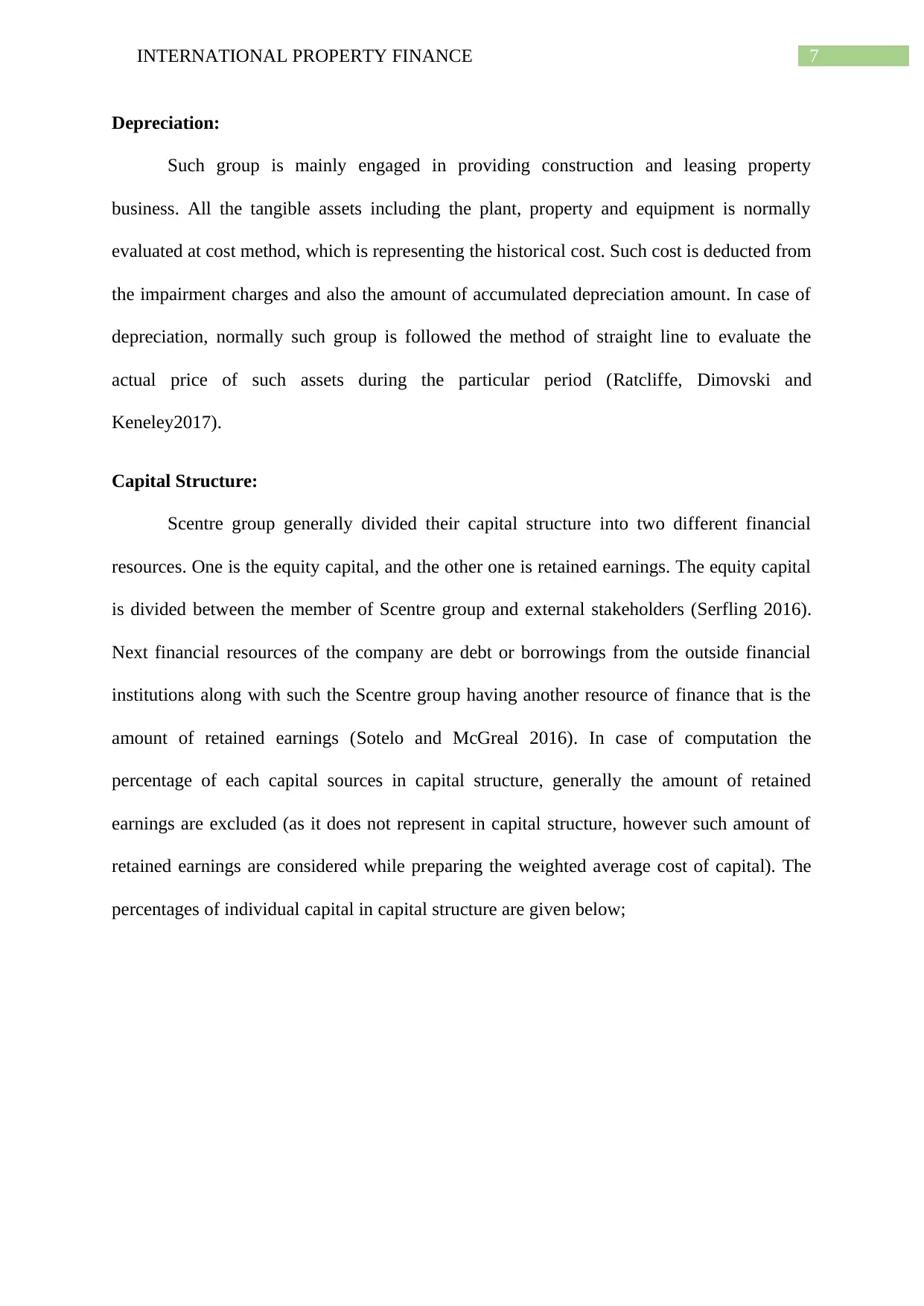
7INTERNATIONAL PROPERTY FINANCE
Depreciation:
Such group is mainly engaged in providing construction and leasing property
business. All the tangible assets including the plant, property and equipment is normally
evaluated at cost method, which is representing the historical cost. Such cost is deducted from
the impairment charges and also the amount of accumulated depreciation amount. In case of
depreciation, normally such group is followed the method of straight line to evaluate the
actual price of such assets during the particular period (Ratcliffe, Dimovski and
Keneley2017).
Capital Structure:
Scentre group generally divided their capital structure into two different financial
resources. One is the equity capital, and the other one is retained earnings. The equity capital
is divided between the member of Scentre group and external stakeholders (Serfling 2016).
Next financial resources of the company are debt or borrowings from the outside financial
institutions along with such the Scentre group having another resource of finance that is the
amount of retained earnings (Sotelo and McGreal 2016). In case of computation the
percentage of each capital sources in capital structure, generally the amount of retained
earnings are excluded (as it does not represent in capital structure, however such amount of
retained earnings are considered while preparing the weighted average cost of capital). The
percentages of individual capital in capital structure are given below;
Depreciation:
Such group is mainly engaged in providing construction and leasing property
business. All the tangible assets including the plant, property and equipment is normally
evaluated at cost method, which is representing the historical cost. Such cost is deducted from
the impairment charges and also the amount of accumulated depreciation amount. In case of
depreciation, normally such group is followed the method of straight line to evaluate the
actual price of such assets during the particular period (Ratcliffe, Dimovski and
Keneley2017).
Capital Structure:
Scentre group generally divided their capital structure into two different financial
resources. One is the equity capital, and the other one is retained earnings. The equity capital
is divided between the member of Scentre group and external stakeholders (Serfling 2016).
Next financial resources of the company are debt or borrowings from the outside financial
institutions along with such the Scentre group having another resource of finance that is the
amount of retained earnings (Sotelo and McGreal 2016). In case of computation the
percentage of each capital sources in capital structure, generally the amount of retained
earnings are excluded (as it does not represent in capital structure, however such amount of
retained earnings are considered while preparing the weighted average cost of capital). The
percentages of individual capital in capital structure are given below;
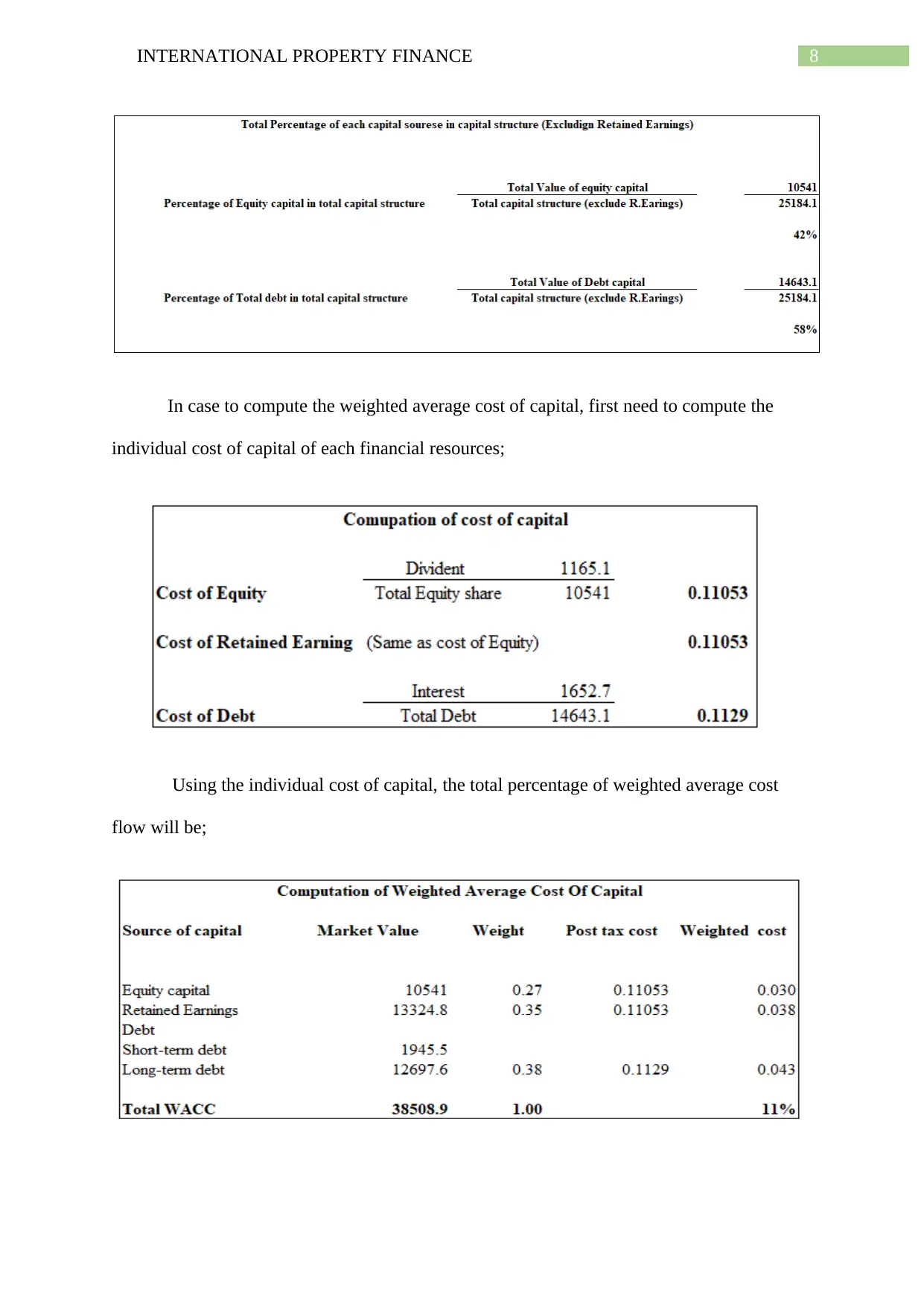
8INTERNATIONAL PROPERTY FINANCE
In case to compute the weighted average cost of capital, first need to compute the
individual cost of capital of each financial resources;
Using the individual cost of capital, the total percentage of weighted average cost
flow will be;
In case to compute the weighted average cost of capital, first need to compute the
individual cost of capital of each financial resources;
Using the individual cost of capital, the total percentage of weighted average cost
flow will be;
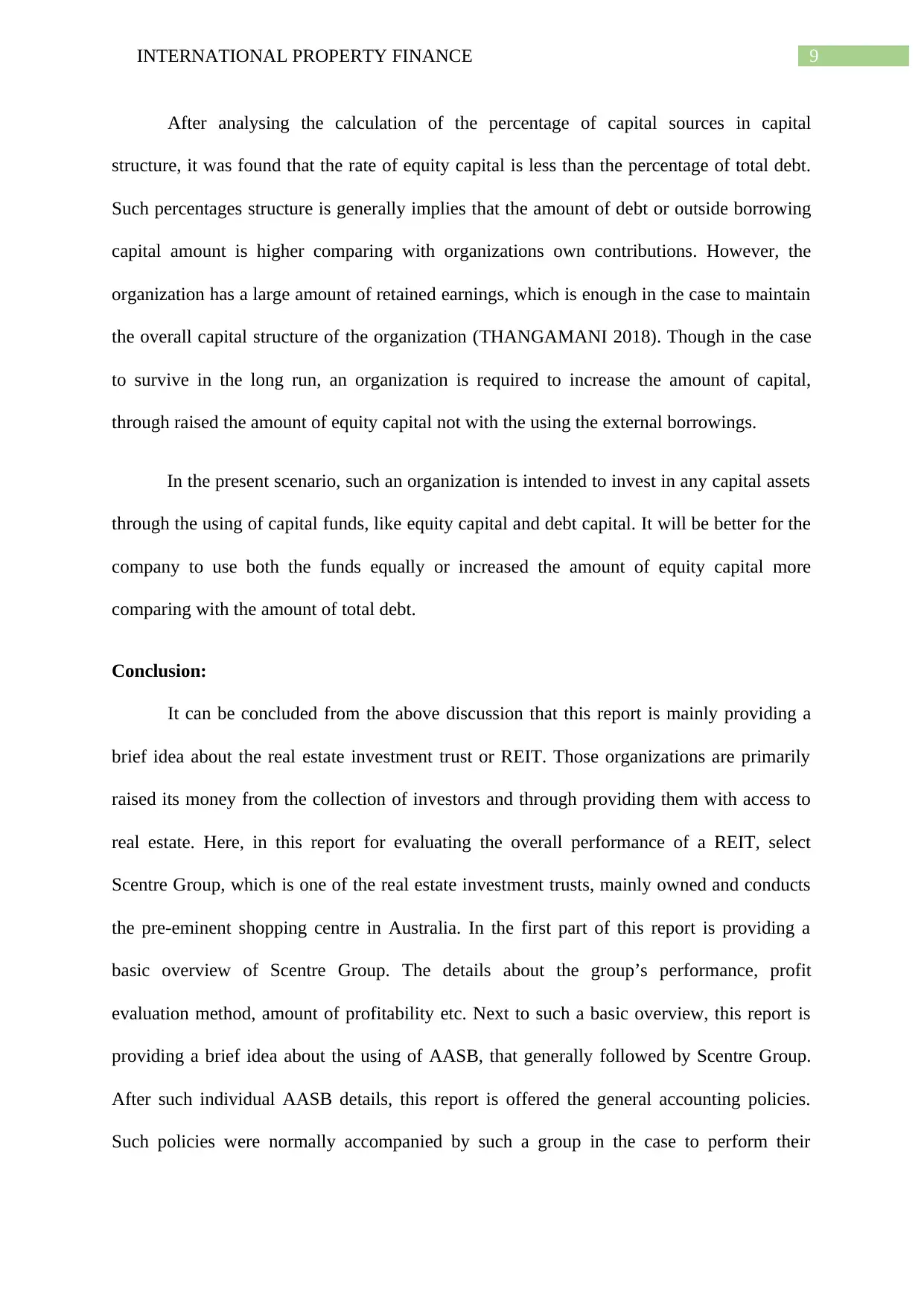
9INTERNATIONAL PROPERTY FINANCE
After analysing the calculation of the percentage of capital sources in capital
structure, it was found that the rate of equity capital is less than the percentage of total debt.
Such percentages structure is generally implies that the amount of debt or outside borrowing
capital amount is higher comparing with organizations own contributions. However, the
organization has a large amount of retained earnings, which is enough in the case to maintain
the overall capital structure of the organization (THANGAMANI 2018). Though in the case
to survive in the long run, an organization is required to increase the amount of capital,
through raised the amount of equity capital not with the using the external borrowings.
In the present scenario, such an organization is intended to invest in any capital assets
through the using of capital funds, like equity capital and debt capital. It will be better for the
company to use both the funds equally or increased the amount of equity capital more
comparing with the amount of total debt.
Conclusion:
It can be concluded from the above discussion that this report is mainly providing a
brief idea about the real estate investment trust or REIT. Those organizations are primarily
raised its money from the collection of investors and through providing them with access to
real estate. Here, in this report for evaluating the overall performance of a REIT, select
Scentre Group, which is one of the real estate investment trusts, mainly owned and conducts
the pre-eminent shopping centre in Australia. In the first part of this report is providing a
basic overview of Scentre Group. The details about the group’s performance, profit
evaluation method, amount of profitability etc. Next to such a basic overview, this report is
providing a brief idea about the using of AASB, that generally followed by Scentre Group.
After such individual AASB details, this report is offered the general accounting policies.
Such policies were normally accompanied by such a group in the case to perform their
After analysing the calculation of the percentage of capital sources in capital
structure, it was found that the rate of equity capital is less than the percentage of total debt.
Such percentages structure is generally implies that the amount of debt or outside borrowing
capital amount is higher comparing with organizations own contributions. However, the
organization has a large amount of retained earnings, which is enough in the case to maintain
the overall capital structure of the organization (THANGAMANI 2018). Though in the case
to survive in the long run, an organization is required to increase the amount of capital,
through raised the amount of equity capital not with the using the external borrowings.
In the present scenario, such an organization is intended to invest in any capital assets
through the using of capital funds, like equity capital and debt capital. It will be better for the
company to use both the funds equally or increased the amount of equity capital more
comparing with the amount of total debt.
Conclusion:
It can be concluded from the above discussion that this report is mainly providing a
brief idea about the real estate investment trust or REIT. Those organizations are primarily
raised its money from the collection of investors and through providing them with access to
real estate. Here, in this report for evaluating the overall performance of a REIT, select
Scentre Group, which is one of the real estate investment trusts, mainly owned and conducts
the pre-eminent shopping centre in Australia. In the first part of this report is providing a
basic overview of Scentre Group. The details about the group’s performance, profit
evaluation method, amount of profitability etc. Next to such a basic overview, this report is
providing a brief idea about the using of AASB, that generally followed by Scentre Group.
After such individual AASB details, this report is offered the general accounting policies.
Such policies were normally accompanied by such a group in the case to perform their
Secure Best Marks with AI Grader
Need help grading? Try our AI Grader for instant feedback on your assignments.
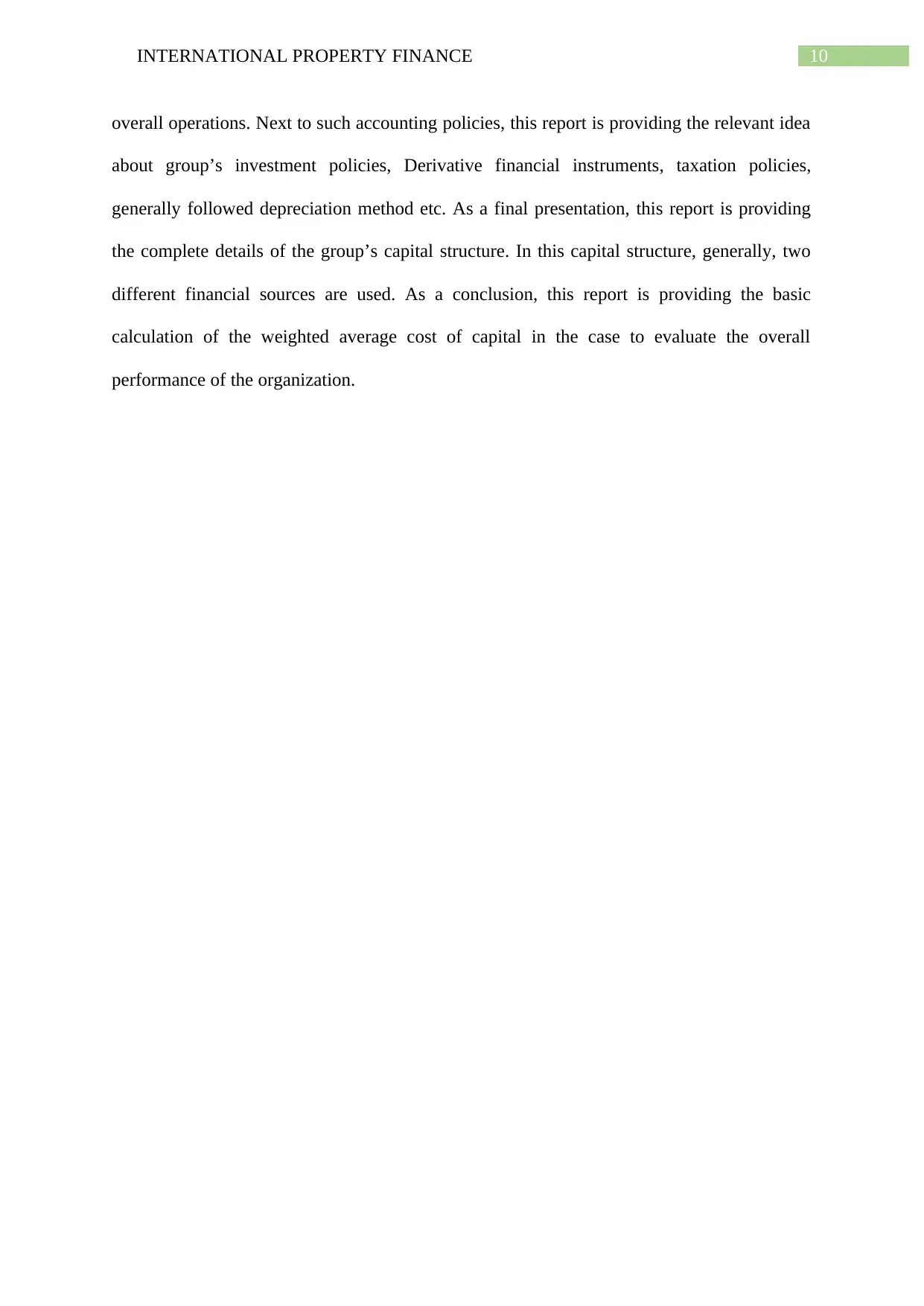
10INTERNATIONAL PROPERTY FINANCE
overall operations. Next to such accounting policies, this report is providing the relevant idea
about group’s investment policies, Derivative financial instruments, taxation policies,
generally followed depreciation method etc. As a final presentation, this report is providing
the complete details of the group’s capital structure. In this capital structure, generally, two
different financial sources are used. As a conclusion, this report is providing the basic
calculation of the weighted average cost of capital in the case to evaluate the overall
performance of the organization.
overall operations. Next to such accounting policies, this report is providing the relevant idea
about group’s investment policies, Derivative financial instruments, taxation policies,
generally followed depreciation method etc. As a final presentation, this report is providing
the complete details of the group’s capital structure. In this capital structure, generally, two
different financial sources are used. As a conclusion, this report is providing the basic
calculation of the weighted average cost of capital in the case to evaluate the overall
performance of the organization.
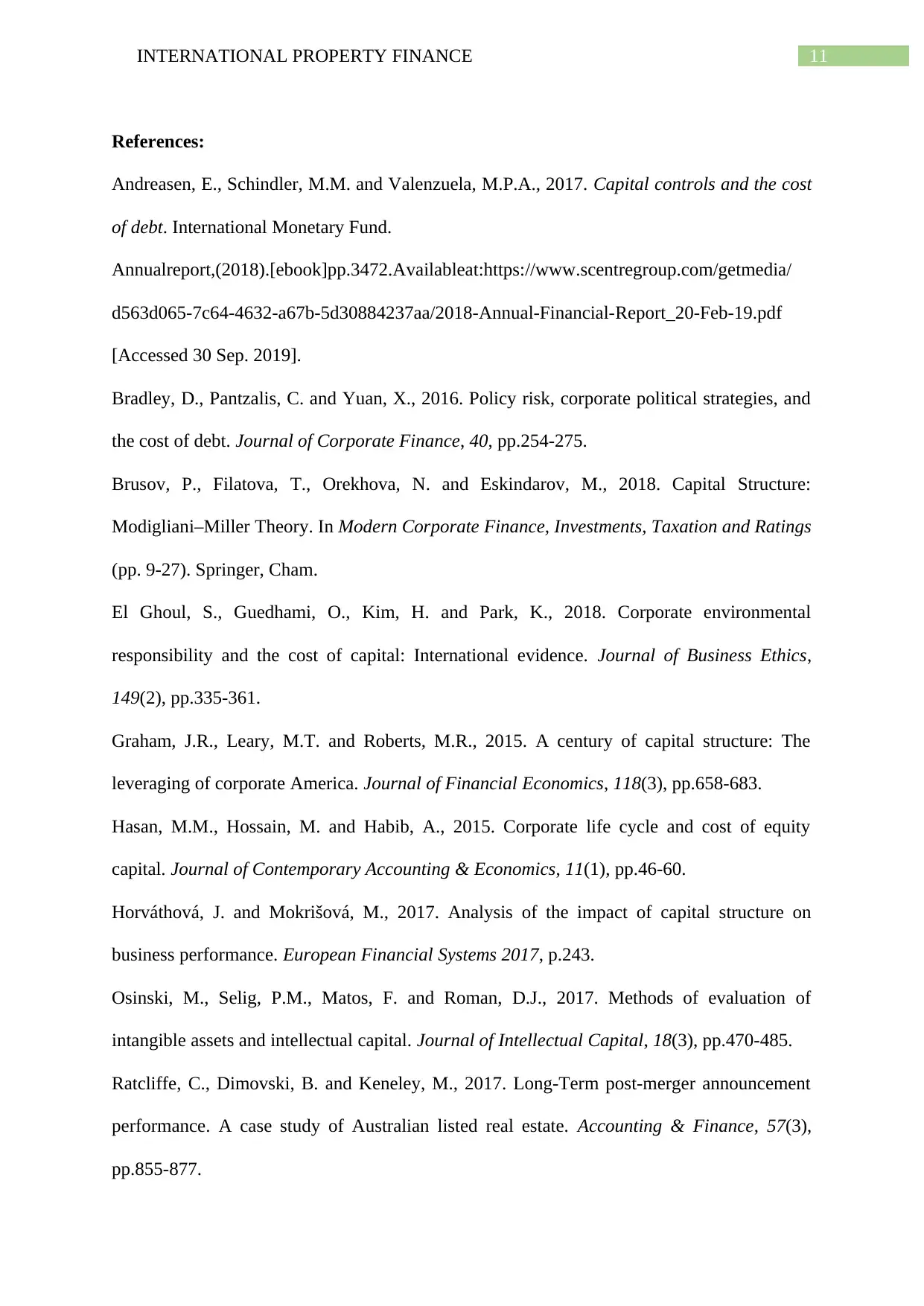
11INTERNATIONAL PROPERTY FINANCE
References:
Andreasen, E., Schindler, M.M. and Valenzuela, M.P.A., 2017. Capital controls and the cost
of debt. International Monetary Fund.
Annualreport,(2018).[ebook]pp.3472.Availableat:https://www.scentregroup.com/getmedia/
d563d065-7c64-4632-a67b-5d30884237aa/2018-Annual-Financial-Report_20-Feb-19.pdf
[Accessed 30 Sep. 2019].
Bradley, D., Pantzalis, C. and Yuan, X., 2016. Policy risk, corporate political strategies, and
the cost of debt. Journal of Corporate Finance, 40, pp.254-275.
Brusov, P., Filatova, T., Orekhova, N. and Eskindarov, M., 2018. Capital Structure:
Modigliani–Miller Theory. In Modern Corporate Finance, Investments, Taxation and Ratings
(pp. 9-27). Springer, Cham.
El Ghoul, S., Guedhami, O., Kim, H. and Park, K., 2018. Corporate environmental
responsibility and the cost of capital: International evidence. Journal of Business Ethics,
149(2), pp.335-361.
Graham, J.R., Leary, M.T. and Roberts, M.R., 2015. A century of capital structure: The
leveraging of corporate America. Journal of Financial Economics, 118(3), pp.658-683.
Hasan, M.M., Hossain, M. and Habib, A., 2015. Corporate life cycle and cost of equity
capital. Journal of Contemporary Accounting & Economics, 11(1), pp.46-60.
Horváthová, J. and Mokrišová, M., 2017. Analysis of the impact of capital structure on
business performance. European Financial Systems 2017, p.243.
Osinski, M., Selig, P.M., Matos, F. and Roman, D.J., 2017. Methods of evaluation of
intangible assets and intellectual capital. Journal of Intellectual Capital, 18(3), pp.470-485.
Ratcliffe, C., Dimovski, B. and Keneley, M., 2017. Long‐Term post‐merger announcement
performance. A case study of Australian listed real estate. Accounting & Finance, 57(3),
pp.855-877.
References:
Andreasen, E., Schindler, M.M. and Valenzuela, M.P.A., 2017. Capital controls and the cost
of debt. International Monetary Fund.
Annualreport,(2018).[ebook]pp.3472.Availableat:https://www.scentregroup.com/getmedia/
d563d065-7c64-4632-a67b-5d30884237aa/2018-Annual-Financial-Report_20-Feb-19.pdf
[Accessed 30 Sep. 2019].
Bradley, D., Pantzalis, C. and Yuan, X., 2016. Policy risk, corporate political strategies, and
the cost of debt. Journal of Corporate Finance, 40, pp.254-275.
Brusov, P., Filatova, T., Orekhova, N. and Eskindarov, M., 2018. Capital Structure:
Modigliani–Miller Theory. In Modern Corporate Finance, Investments, Taxation and Ratings
(pp. 9-27). Springer, Cham.
El Ghoul, S., Guedhami, O., Kim, H. and Park, K., 2018. Corporate environmental
responsibility and the cost of capital: International evidence. Journal of Business Ethics,
149(2), pp.335-361.
Graham, J.R., Leary, M.T. and Roberts, M.R., 2015. A century of capital structure: The
leveraging of corporate America. Journal of Financial Economics, 118(3), pp.658-683.
Hasan, M.M., Hossain, M. and Habib, A., 2015. Corporate life cycle and cost of equity
capital. Journal of Contemporary Accounting & Economics, 11(1), pp.46-60.
Horváthová, J. and Mokrišová, M., 2017. Analysis of the impact of capital structure on
business performance. European Financial Systems 2017, p.243.
Osinski, M., Selig, P.M., Matos, F. and Roman, D.J., 2017. Methods of evaluation of
intangible assets and intellectual capital. Journal of Intellectual Capital, 18(3), pp.470-485.
Ratcliffe, C., Dimovski, B. and Keneley, M., 2017. Long‐Term post‐merger announcement
performance. A case study of Australian listed real estate. Accounting & Finance, 57(3),
pp.855-877.
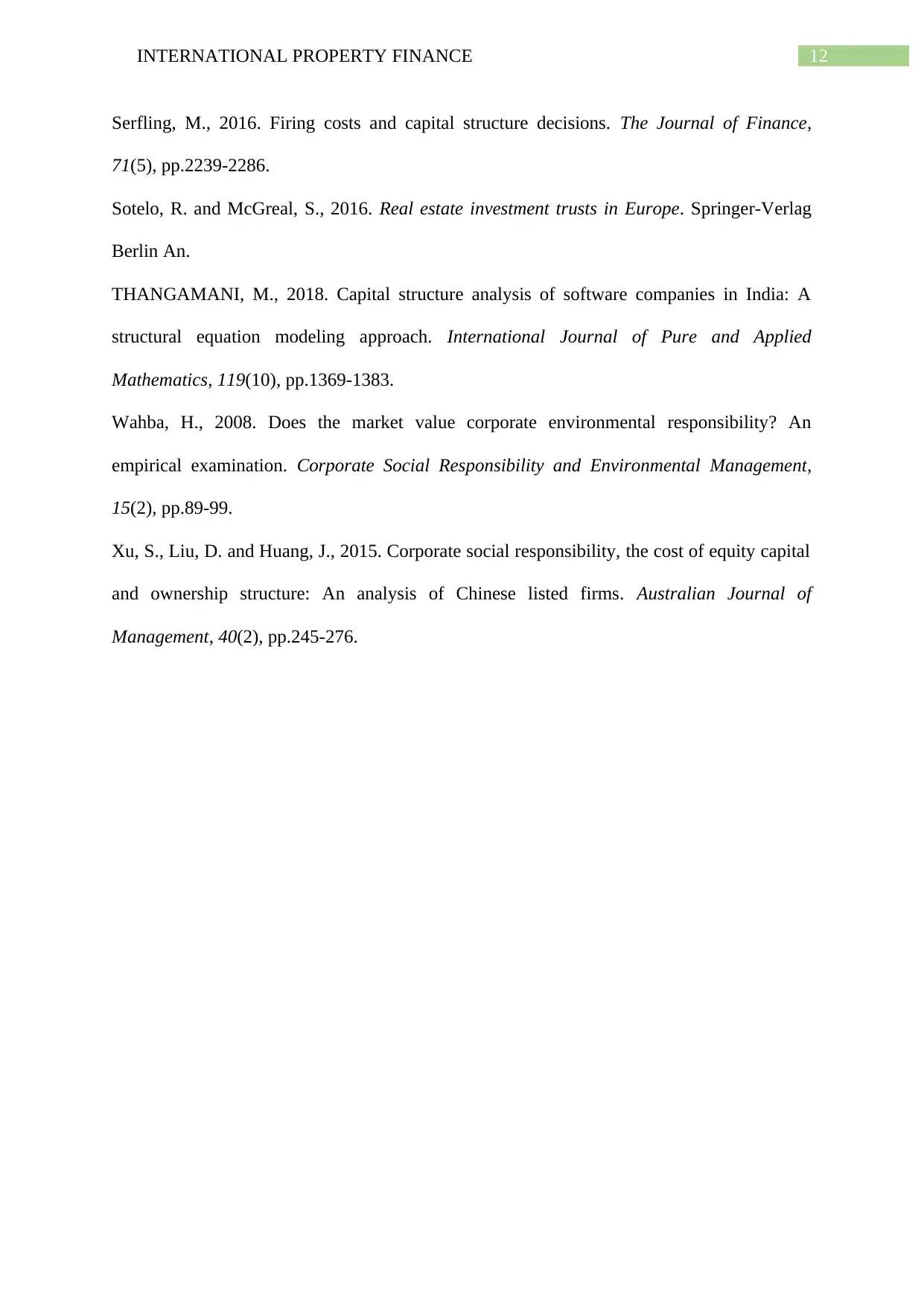
12INTERNATIONAL PROPERTY FINANCE
Serfling, M., 2016. Firing costs and capital structure decisions. The Journal of Finance,
71(5), pp.2239-2286.
Sotelo, R. and McGreal, S., 2016. Real estate investment trusts in Europe. Springer-Verlag
Berlin An.
THANGAMANI, M., 2018. Capital structure analysis of software companies in India: A
structural equation modeling approach. International Journal of Pure and Applied
Mathematics, 119(10), pp.1369-1383.
Wahba, H., 2008. Does the market value corporate environmental responsibility? An
empirical examination. Corporate Social Responsibility and Environmental Management,
15(2), pp.89-99.
Xu, S., Liu, D. and Huang, J., 2015. Corporate social responsibility, the cost of equity capital
and ownership structure: An analysis of Chinese listed firms. Australian Journal of
Management, 40(2), pp.245-276.
Serfling, M., 2016. Firing costs and capital structure decisions. The Journal of Finance,
71(5), pp.2239-2286.
Sotelo, R. and McGreal, S., 2016. Real estate investment trusts in Europe. Springer-Verlag
Berlin An.
THANGAMANI, M., 2018. Capital structure analysis of software companies in India: A
structural equation modeling approach. International Journal of Pure and Applied
Mathematics, 119(10), pp.1369-1383.
Wahba, H., 2008. Does the market value corporate environmental responsibility? An
empirical examination. Corporate Social Responsibility and Environmental Management,
15(2), pp.89-99.
Xu, S., Liu, D. and Huang, J., 2015. Corporate social responsibility, the cost of equity capital
and ownership structure: An analysis of Chinese listed firms. Australian Journal of
Management, 40(2), pp.245-276.
1 out of 13
Related Documents
Your All-in-One AI-Powered Toolkit for Academic Success.
+13062052269
info@desklib.com
Available 24*7 on WhatsApp / Email
![[object Object]](/_next/static/media/star-bottom.7253800d.svg)
Unlock your academic potential
© 2024 | Zucol Services PVT LTD | All rights reserved.





